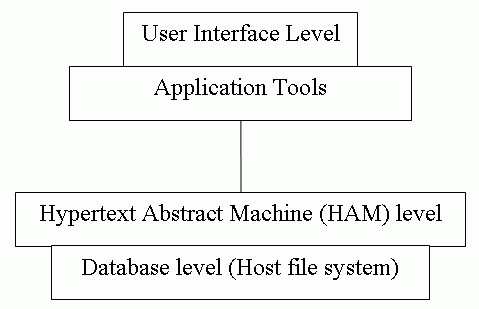
HAM (Hypertext Abstract Machine)In 1987, Brad Campbell and Joseph M. Goodman published HAM at the first ACM Conference on Hypertext. It was a milestone in the development of hypertext as a research field, because it was the first attempt to define a reference model, an abstract model in which actual hypertext systems could be expressed. The internal architecture of a hypertext system can be examined in terms of three levels. These are: Like most reference models, the HAM does not describe the hypertext system completely. The HAM sits in between the file system and the user interface. The HAM is a general purpose, transaction-based, multi-user server for a hypertext storage system. It is a low level storage engine; therefore it provides a general and flexible model that can be used in different hypertext applications. Campbell and Goodman show the typical organization of a system using HAM in the graphical representation given below:
Source: Campbell, B., Goodman, J.M., HAM: A general purpose Hypertext Abstract Machine, CACM 31:7, July 1988. The HAM level is near the host file system; therefore it is a lower level machine. The connection between HAM level and application and user interfaces is looser than HAM level with host file system. From the figure we can tell that HAM is just a part of the system and not the whole. |
| CS6212 - Special Topics in Media Lecturer: Prof George P. Landow |
Final Term Project By: Hendrik Christanto |
